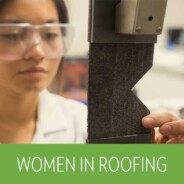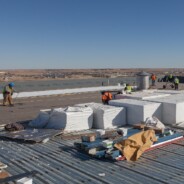Industry Trends
Women’s Equality Day
Since August is a month that, among other things, honors women with National Women’s Equality Day, GenFlex would like to applaud women who have chosen a career in construction and roofing. Saying that women have come a long way in the construction industry is the absolute truth. Annie McEvoy writes in her article, The history of women in the construction industry, and how far they have come, “One of the first documented women in construction was in the late 1800s. Emily Roebling stepped in as the ‘first woman field engineer’ and saw out the completion of the Brooklyn Bridge but only because her husband had become ill. The Brooklyn Bridge opened on May 24, 1883, and Emily was the first to cross it. Louise Blanchard...
read moreFirst Half of 2017 and a Look Forward
As we head into the second half of 2017, let’s review how the year has stacked up so far. According to the U.S. Census Bureau, construction spending for the first four months of the year was $359.5 billion, 5.8 percent above the $339.7 billion for the same period in 2016. If we just look at April’s monthly construction spending, it indicates a seasonally adjusted annual rate of $1.21 trillion. If that number holds true, 2017 will experience a 4.8 percent increase over 2016. It looks like we can be in the range of about 5-6 percent growth in total construction spending. Let’s drill down further into the bureau’s April Value of Construction Put in Place Survey (VIP) results. Private construction spending compared to...
read moreBenefits of a Heat-Welded System
As we all know, “heat-welded roofs” refer to the seams of a roofing membrane that have been fused together with the application of heat. Single-ply thermoplastic polyolefin (TPO) membranes, including GenFlex’s TPO, are typically used. GenFlex EZ TPO and EZ TPO Peel & Stick™ HW are heat-welded roofing membranes made of high‑quality thermoplastic polyolefin. They are excellent choices regardless of configuration, usage, slope, height location or wind exposure. Installation Benefits When comparing heat-welded seams with glued or taped seams, the seam strength is 3–4 times more durable and requires 40–50% less seaming time, reducing labor costs and ultimately making the installation less expensive. Welding can be done...
read moreQ1 2017 Construction Industry Performance
Employment in the construction industry for the first two months in 2017 was up over the same months in 2016, according to the Bureau of Labor Statistics’ Openings and Labor Turnover Survey (JOLTS) report. New hires in January was up 92,000, and in February they were up 22,000 over last year’s numbers. The construction industry added a total of 756,000 new hires in the first two months. March numbers are also looking great. The Associated General Contractors of America (AGC) reports a 2.6% increase in construction employment in March from a year ago, and noted that construction employment is at the highest level since 2008! And, it looks to continue. Manpower’s Employment Outlook Survey for Q2 2017 reports an expected...
read more2016 Commercial Roofing Review and 2017 Forecast
Industry Growth Eighty-eight percent of the Roofing Contractor’s 2016 Commercial Roofing Trends study respondents reported steady or positive growth in 2016! That’s great news for the commercial roofing industry. Furthermore, the U.S. Census Bureau of the Department of Commerce announced on January 3 that during the first 11 months of 2016 (December numbers are not in as of yet), construction spending amounted to $1,070.9 billion, 4.4 percent (±1.0%) above the $1,025.5 billion for the same period in 2015. In fact, the November construction spending reached its highest level in 10 years according to U.S. News and World Report. It looks like 2016 will go down in the books as a decent year for the construction industry as a...
read moreBallasted Roofs Are Cool!
You may not think that a roofing system developed almost fifty years ago could be environmentally friendly. While it’s true not many people were thinking green back then, it turns out ballasted roofs are indeed eco-friendly and worth a look. Ballasted roofs consist of thermal insulation boards (such as the GenFlex Polyiso product), EPDM single‑ply membrane (such as GenFlex FRM EPDM or AFR EPDM), and are topped with smooth, river‑washed stone or concrete pavers. They are easy and quick to install since they require no fasteners and no adhesives, which can be a source of Volatile Organic Compounds (VOCs). Ballasted roofs are also economical and long-lasting. The ballast material protects the membrane from harmful UV rays and...
read moreHeading Into Q4 2016
Heading into Q4 2016, we look to see how the construction industry has performed. Let’s look at the latest numbers from the Value of Construction Put in Place Survey (VIP) by the U.S. Census Bureau, which provides monthly estimates of the total dollar value of construction work done in the U.S. The current numbers are for July 2016. Total construction spending was down ever so slightly at $1.153175 trillion from 1.15352 trillion in June. Nonresidential construction was down slightly coming in at $701.438 billion from 703.493 billion in June. However, the numbers showed gains in office, commercial, health care, and manufacturing construction, which are important sectors to the roofing industry. As for the economy as a whole,...
read moreGreen Roof Systems
A green roof is also referred to as a living roof or a vegetative roof. In simplest terms, it is a roof covered with living plant life. Green roof systems bring nature to the usually stark environment of a building’s rooftop. There are many reasons why more and more building owners are turning to green roof systems. Green roofs enhance the aesthetics of a building. If so designed, the roof can be a park-like area for the building tenants to enjoy as a retreat or perhaps a play area for children. Tenant community food gardens are also possible. Green roofs are great for the environment. They increase air quality since plants can absorb air pollutants and provide a nature habitat for wildlife including birds and butterflies....
read moreLEED® v4 required beginning October of 2016
Roofing Systems Play a Role in Achieving LEED Rating Levels LEED was introduced in 1998, and since then it has become the coveted standard for green and sustainable buildings. Projects can receive one of four LEED-rating levels: Certified, Silver, Gold, and Platinum. LEED Version 4 (v4) raises the technical standards and broadens the scope of the previous version, LEED 2009. New real estate sectors are now under scope including data centers, warehouse and distribution centers, hospitality buildings (hotels), and multi-family mid-rise residential buildings. It also now includes existing schools and retail buildings. LEED rates a project based on multiple credit categories. These categories are Sustainable Sites (SS), Water...
read moreWomen in Roofing
The U.S. Bureau of Labor Statistics’ Women in the labor force: a databook, December 2015 indicates that in 2014, women accounted for only .5 percent of roofers. If you look at the statistics you might think that women are not really involved in the roofing industry, at all. However, while it is true that there may not be very many women using nail guns on rooftops, it is equally true that there are a great many women who are involved in all other facets of the industry. Some of the areas of involvement include: Entrepreneurship, Management, Administration, Sales/Marketing, Roofing Technology, and Estimating. Recognizing there was a need for a nationwide-organization representing and supporting women in the business, National Women...
read more









